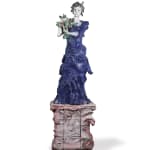
Lucio Fontana Argentine-Italian, 1899-1968
Further images
Figura Femminile con Fiori (1948) is a seminal sculpture from Fontana's oeuvre and stands at the pinnacle of the artist's achievements in sculpture and ceramics. The present work has been included in a number of major institutional exhibitions including Lucio Fontana: Retrospective (The Musée d'Art moderne de la Ville de Paris, Paris) and the travelling exhibition Lucio Fontana, Entre Matéria y Espacio (Museo Nacional Centro de Arte Reina Sofía, Madrid; Fundació La Caixa, Mallorca).
Fontana's sculptures mark the genesis of his ceaseless exploration of Spatialism and Figura Femminile con Fiori was created at a critical time in Fontana's shift from figuration to abstraction. In 1945, Fontana moved to Albisolas, Italy, to study under Futurist ceramicist Tullio Mazzotti and the following year, 1946, Fontana published his first manifesto, Manifesto Blanco, in Buenos Aires, which called for a synthesis of space, time, colour, sound and movement in art. This manifesto echoed the spatiality and suggested the movement of Baroque art and the dynamism of Futurism.
Identified as a portrait of Fontana's wife Teresita Rasini, the vibrant female figure stands in a classical contrapposto pose, activating the space around it with Fontana's dynamic gestural handling. Figura Femminile con Fiori perfectly demonstrates Fontana's complex understanding of three-dimensional form and represents the artist's longstanding emphasis on matter and movement.
